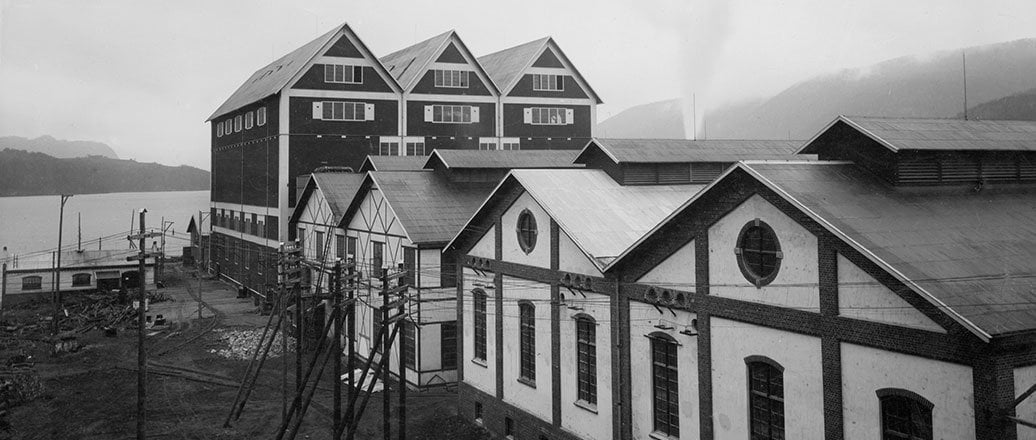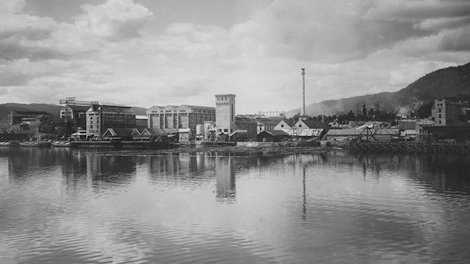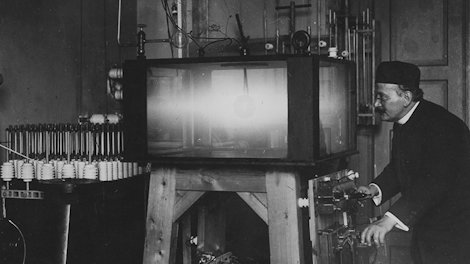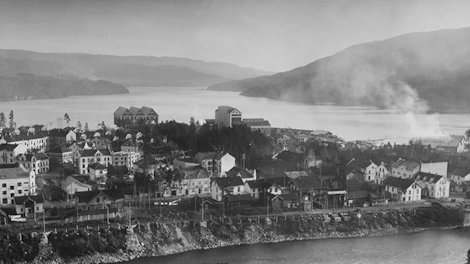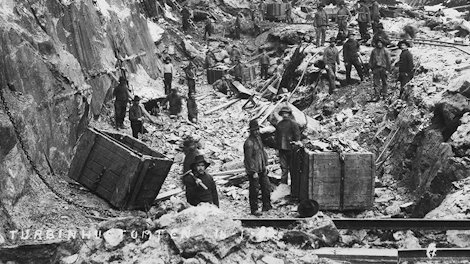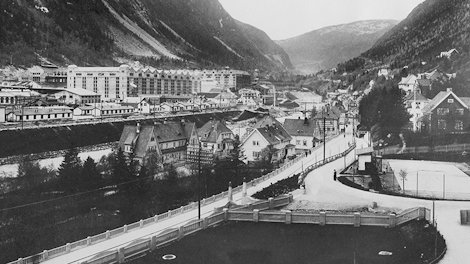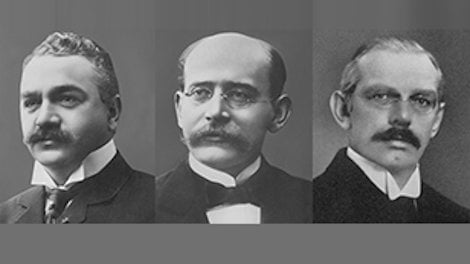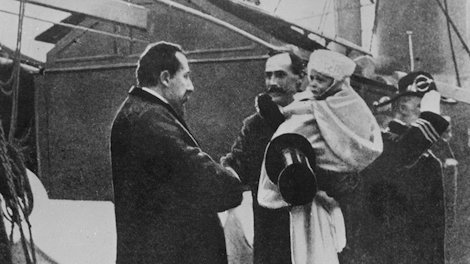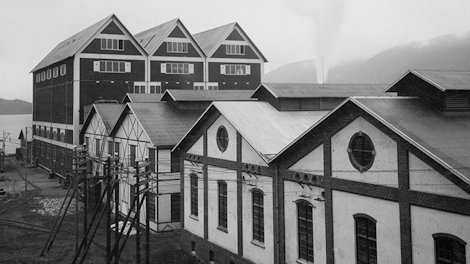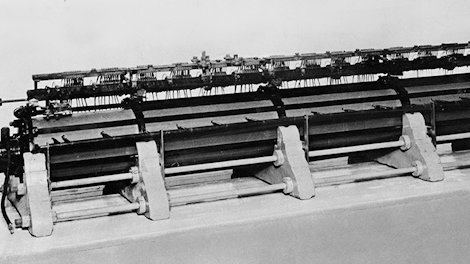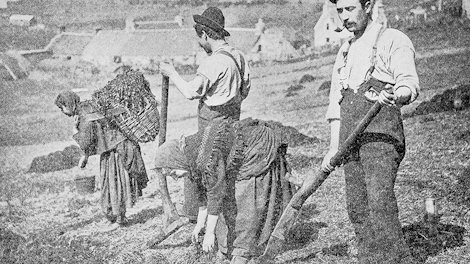It was a question of drawing the long straw in the knife-sharp international competition for investment, and it was by no means a matter or course that this new branch of industry should be developed to a commercial level in Norway.
But the country was not without its advantages: releasing nitrogen from the air requires great amounts of energy, and that energy could be harnessed from Norway’s plentiful waterfalls. Electricity could be produced more cheaply in Norway than almost anywhere else.
Birkeland, Eyde and the engineers
Engineer Eyde had not only acquired rights to develop waterfalls, he also ran a highly successful engineering firm. During the first months after Birkeland and Eyde signed their agreement in 1903, they conducted experiments in Christiania (now Oslo). Professor Birkeland was in charge of the technical development of the arc method and the experiments. Other engineers were brought in for chemical trials.
The staff on the project worked hard and their enthusiasm was fuelled by Eyde, who saw the potential scope of these tasks. Several of Eyde’s engineers were engaged in day-to-day operations. At first, chemical engineers from the University of Kristiania (Oslo) were engaged. Later, several more engineers were brought into the project.
These practical and systematic engineers played a vital role in documenting results and developing the project to an industrial scale.
The Wallenbergs and Elkem
In the autumn of 1903, Sam Eyde and one of his partners, the Swedish industrialist Knut Tillberg, campaigned to gain the interest of both German and Swedish investors. Towards the end of the year, two Swedish investors, the half-brothers Knut and Marcus Wallenberg, joined the project. This led to the establishment of the company Elektrokemisk – Elkem, which is now a major international supplier of metals and materials.
Eyde had already been to Germany twice and negotiated with the management of BASF, but they concluded that the arc method was still too uncertain to warrant risking a substantial amount of capital.
The Swedes, however, had entered the arena with the backing of Enskilda Bank of Stockholm, and became long-term partners in the industrial development of Norway.
From laboratory to factory
Notodden, in the south of Norway, was chosen as the site for taking the leap from laboratory to factory. The area was ideal, as a hydroelectric power station had already been built there in 1901. The nitrate company Notodden Salpeterfabriker AS was established in Notodden in 1904, and from the autumn of that year, construction was in full swing.
Outside a select circle, it was still unclear what the investors were expecting from the Notodden plant. “Isn’t it an experimental unit?” asked a local newspaper. The date is 24 September 1904, and the question is directed to the 26 year old engineer Sigurd Kloumann, who is in charge of the construction job. “No,” he answers. “It’s a factory.”
The experiments continued, but plans had meanwhile been made for the gas absorption facility - two rows of sandstone and a ten meter granite tower filled with quartz, to which was later added another tower filled with masonry sprinkled with lime. This allowed the production of nitric acid to rise to well over 500 kilos per kilowatt year.
Production began in Notodden on 2 May,1905, with around 100 workers employed at the factory. This was envisaged as a first step towards a much larger project, but these plans would soon change.
Even before there was any good documentation on how production was progressing, work was already underway to get an even more important investor on board. Sights were set on the French bank, Paribas (Banque de Paris et des Pays-Bas).
The experts arrive...
“Representatives for the Banque de Paris et des Pays-Bas, a total of 12 persons, who are to visit Notodden (...) to consider investing in the waterfall, will arrive today on the continental train at 6.15 a.m...” reported the national daily newspaper Aftenposten on 14 July 1905. Not a very precise description. This was in fact a commission of top league experts in industry, chemistry and agronomics.
It was rather like a visit from external examiners. They had to make a good impression, document that the factory could produce a sufficient amount of nitric acid, and – not least – show that the product was up to expectations.
...and are impressed
Two reports were drawn up on their return. One pointed out that the Scandinavians had secured favorable hydroelectric power rights and made positive mention of the capital and operational costs and the electric arc furnace.
The second, written by chemists, stated that the value of the fertilizer was indubitable. They felt that the absorption system could be further improved, and praised the efforts made so far. The threshold for profitability was set at 500 kilos per kilowatt year.
The results may not have been totally convincing, but the commission of experts put in a good word. The remaining problems could be solved:
“However we feel unable to complete our work without pointing out the fertile innovation, the exceptional enterprise and the opportune boldness the authors of this process, their employees and investors, have shown in solving such a weighty problem and building up such a remarkable piece of work in such a short time. And for anyone wishing to predict the future, it has to be said that these qualities should not be underestimated as factors of success in the work still to be done.
Banque Paribas invests
The groundwork was now laid for new talks with Banque Paribas. The Wallenbergs, Tillberg and Eyde travelled to Paris at the end of August, and returned with NOK 2.5 million (EUR 300,000 at 2003 exchange rate) for further work at Notodden.
The agreement with Banque Paribas was mostly to the credit of the Wallenberg brothers, who paved the way for securing the French capital. Eyde’s role during this phase lay mostly in driving the project forward.
Even though the involvement of Banque Paribas was limited, it provided the means to develop the Svelgfoss waterfall to provide electricity for a new, larger facility at Notodden.
Updated: August 17, 2020







